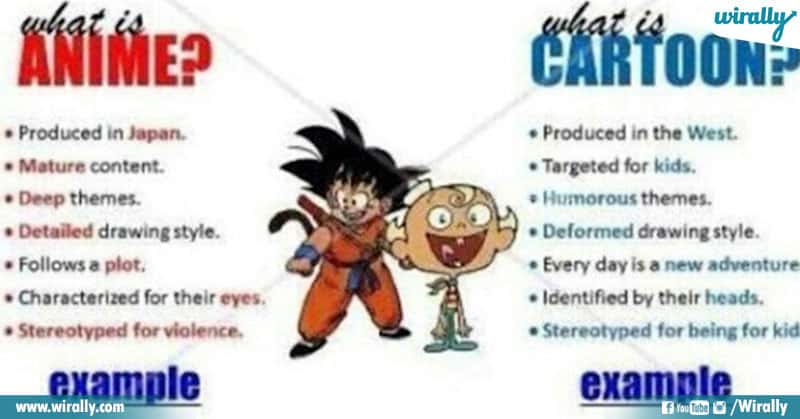Have you ever wondered what sets a cartoon apart from anime? The vibrant colors, the whimsical characters, the captivating stories – both animation forms offer a unique window into imagination and storytelling. While they might seem similar at first glance, these artistic mediums have distinct roots, styles, and cultural significance. This article delves into the fascinating world of cartoon vs anime, exploring their histories, techniques, and the reasons why they captivate audiences worldwide.

Image:
From the classic Disney cartoons to the epic sagas of Studio Ghibli, animation has evolved tremendously over the years. Cartoons and anime hold a special place in our hearts, providing entertainment and escapism for generations. Understanding their differences and appreciating their shared artistry allows for a deeper appreciation of the animated landscape.
Tracing the Roots of Cartoon and Anime
Cartoon: A Western Legacy
The origins of cartoons can be traced back to the late 19th century, with pioneers like Émile Reynaud and J. Stuart Blackton experimenting with early forms of animation. The term “cartoon” itself originally referred to preparatory sketches for artwork. However, it gained popularity as a descriptor for animated films, particularly in the United States.
The golden age of American animation is often associated with Walt Disney, who revolutionized the industry with innovative techniques and timeless characters. The emergence of studios like Warner Bros., MGM, and Fleischer Studios brought iconic characters like Mickey Mouse, Bugs Bunny, and Popeye to life, shaping the visual language and storytelling conventions of cartoons that still influence animation today.
Anime: A Japanese Tradition
Anime, short for “animation” in Japanese, has a distinct origin story. Its roots can be traced back to the early 20th century, with influential pioneers like Osamu Tezuka. Tezuka’s “Astro Boy” (1963) is considered a cornerstone of modern anime, establishing the visual style and storytelling techniques that have come to define the genre.
Unlike Western cartoons, anime often incorporates elements of manga, Japanese comics, which provide rich source material for stories. The anime industry blossomed in the 1970s and 1980s, with popular series like “Mobile Suit Gundam,” “Dragon Ball Z,” and “Sailor Moon” captivating audiences around the world. Anime’s artistic expression and narrative depth have played a significant role in shaping its global appeal.

Image:
Cartoon vs Anime: A Comparative Glance
While both cartoon and anime are forms of animation, they diverge in several key aspects:
Visual Style
Cartoon: Cartoons are known for their simplified, exaggerated, and often humorous style. Characters are usually depicted with large heads, expressive features, and fluid movements. The use of bright colors and bold lines adds to their vibrant and playful aesthetic.
Anime: Anime often embraces a more realistic style, although its artistic expression varies greatly. Characters can range from exaggerated and whimsical to intricately detailed and lifelike. The use of shadows, lighting, and dynamic camera angles contribute to the visual depth and storytelling potential of anime.
Storytelling and Themes
Cartoon: Cartoons are generally targeted towards a broader audience, including children. The stories often revolve around humor, adventure, or simple moral lessons. Cartoons often utilize slapstick comedy, puns, and recurring gags to create lighthearted entertainment.
Anime: Anime covers a vast range of genres, from action and fantasy to romance and psychological thrillers. The stories can be complex, emotionally charged, and often explore profound themes like identity, loss, and societal issues. Anime’s versatility allows for diverse storytelling and caters to a wide range of interests.
Character Development
Cartoon: While cartoons feature memorable characters, they often prioritize the humor and action over complex character development. Characters tend to be one-dimensional, embodying specific personality traits or archetypes.
Anime: Character development is a crucial element of anime. Characters often undergo significant transformations, evolving both physically and emotionally throughout the story. Anime delves into the characters’ backstories, motivations, and relationships, fostering emotional connection with the audience.
Production Techniques
Cartoon: Historically, cartoons were primarily hand-drawn, using traditional animation techniques. However, the advent of digital animation has revolutionized the industry, allowing for more complex and fluid movements.
Anime: While traditional animation methods are still prevalent in anime, the industry has embraced digital animation, utilizing software like Toon Boom Harmony and Adobe After Effects. The use of CGI is increasing, particularly in action-heavy sequences and special effects.
Unveiling the Cultural Significance
Beyond their artistic differences, cartoons and anime have distinct cultural significance. Cartoons have played a significant role in American culture, shaping attitudes, values, and the way we view the world. They have served as a platform for social commentary, exploring themes of race, gender, and societal norms.
On the other hand, anime is deeply intertwined with Japanese culture. It reflects the nation’s artistic sensibilities, storytelling traditions, and philosophical outlook. Anime has become an ambassador for Japanese culture, introducing its unique aesthetics and values to a global audience.
The Evolution and Future of Cartoon and Anime
Both cartoon and anime continue to evolve and adapt to the changing landscape of entertainment. New technologies, artistic styles, and storytelling approaches are constantly emerging. Digital animation has opened up new possibilities, allowing for enhanced realism and immersive experiences.
Cartoons have embraced diverse themes and target audiences, from the comedic exploits of “Rick and Morty” to the social satire of “South Park.” Anime also continues to explore diverse genres, from the action-packed “Attack on Titan” to the thought-provoking “Neon Genesis Evangelion.” The animation industry is dynamic and constantly pushing creative boundaries.
Cartoon Vs Anime
Conclusion: A Shared Legacy
The distinction between cartoon and anime is not always clear-cut. Both forms of animation have unique artistic sensibilities and cultural significance. Understanding their differences allows us to appreciate the rich tapestry of animation, with its boundless creativity and capacity to inspire, entertain, and challenge audiences worldwide. So, whether you’re captivated by the humor of cartoons or the dramatic depth of anime, both forms of animation deserve to be celebrated for their artistry and lasting impact on pop culture. Explore the world of animation and discover the endless possibilities it holds!






